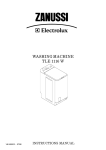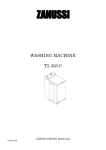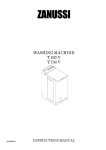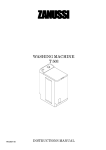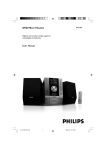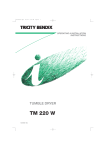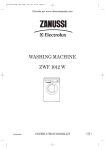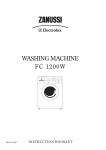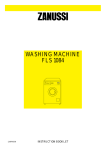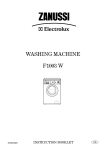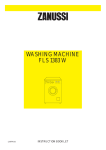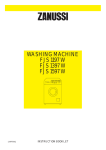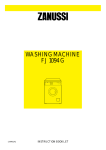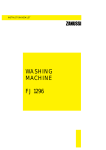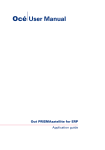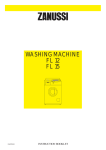Download Zanussi 434 User's Manual
Transcript
ZANUSSI Washing Machine TJS1397W INSTRUCTION BOOKLET Important Safety Information It is most important that this instruction book should be retained with the appliance for future reference. Should the appliance be sold or transferred to another owner, or should you move house and leave the appliance, always ensure that the book is supplied with the appliance in order that the new owner can get to know the functioning of the appliance and the relevant warnings. These warnings have been provided in the interest of safety. You MUST read them carefully before installing or using the appliance. Installation Use This appliance is heavy. Care should be taken when moving it. Always unplug the appliance and turn off the water supply after use. It is dangerous to alter the specifications or attempt to modify this appliance in any way. Do not overload the appliance. See relevant section in the instruction book. All packaging and transit bolts must be removed before use. Serious damage can occur to the product and to property if this is not adhered to. See relevant section in instructions. Only wash fabrics which are designed to be machine washed. If in doubt, consult the care label on the clothes. Before washing, ensure that all pockets are empty and buttons and zips are fastened. Avoid washing frayed or torn articles and treat stains such as paint, ink, rust, and grass before washing . Underwired bras must NOT be machine washed. Any plumbing work required to install this appliance should be carried out by a qualified plumber or competent person. Any electrical work required to install this appliance should be carried out by a qualified electrician or competent person. Any objects such as coins, safety pins, nails, screws, stones or any other hard, sharp material can cause extensive damage and must not be placed into the machine. Care must be taken to ensure that the appliance does not stand on the electrical supply cable. If the machine is situated on a carpeted floor, please adjust the feet in order to allow air to circulate freely. Garments which have been in contact with volatile petroleum products should not be machine washed. If volatile cleaning fluids are used, care should be taken to ensure that the fluid is removed from the garment before placing in the machine. Child Safety Wash small items such as socks, laces, washable belts etc in a washing bag or pillow case as it is possible for such items so slip down between the tub and the inner drum. This appliance is designed to be operated by adults. Children should not be allowed to tamper with the controls or play with the appliance. Pets and children have been known to climb into washing machines. Please check your drum before use. Only use the advised quantities of fabric softener. Damage to the fabric can ensue if you over-fill. Refer to the manufacturer's recommendations of quantities. Keep all packaging well away from children. As some duvets and eiderdowns should be washed in large commercial machines because of their bulk, please check with the manufacturer of the item before washing in a domestic machine. Keep all detergents in a safe place out of children's reach. Under no circumstances should you attempt to repair the machine yourself. Repairs carried out by inexperienced persons may cause injury or serious malfunctioning. Contact your local Zanussi Service Force Centre. Always insist on genuine Zanussi spare parts. 3 Contents For the Installer For the User Important Safety Information 3 Installation Instructions 20 Your New Washing Machine 5 Description of the Appliance Detergent Dispenser 6 6 The Control Panel 7 Technical Specifications Unpacking Positioning Levelling Moving the appliance Special conditions Water inlet Water drainage In the interest of the environment Electrical connection 20 21 21 22 22 22 23 23 ?? 24 Operating Sequence Before use Load the laundry Measure out the detergent Measure out the fabric softener Select the required option Select the required spin speed Select the required programme Start the machine At the end of the programme Washing Hints Which detergent ? ... And in which form ? 8-9 8 8 8 8 8 9 9 9 9 10-11 11 11 Wash Care Symbols 12 Washing programmes 13-14 Maintenance and Cleaning Descaling After each wash External cleaning Cleaning the detergent dispenser Cleaning the drain filter The dangers of freezing 15-16 15 15 15 15 15-16 16 Something Not Working 17 Service and Spare Parts 18 Peace of Mind for Twelve Months 19 Guide to use the Instruction Book The following symbols will be found in the text to guide you throughout the instructions: Safety instructions Hints and tips Environmental information 4 Your New Washing Machine Your new washing machine meets all modern requirements for effective treatment of laundry with low water, energy and detergent consumption. Ecological hints In the interest of the environment To save water and energy and help protect the environment, we recommend that you follow these hints: Materials marked with the symbol recyclable. are Check with your local Council or Environmental Health Office to see if there are facilities in your area for re-cycling this appliance. Adjust the quantity of detergent according to the hardness of your water supply, the amount of laundry and the degree of soiling. When the appliance is to be scrapped, cut off the power supply cable and make the door lock device unusable to prevent young children from being trapped inside. A programme without prewash is sufficient for normally soiled laundry. Help to keep your country tidy - use authorised disposal sites for your old appliance. How do we help to protect the environment? We use recycled paper! Important Your machine is fitted with a balance control device, which ensures the machine is stable during the spin. If the wash load appears not to have been spun sufficiently at the end of the wash cycle, because, it is not evenly distributed in the drum, the balance control device may have operated. It will therefore be necessary to redistribute the wash load manually and select a spin programme. For more detailed information see the section headed "Something Not Working". 5 Description of the Appliance Programme selector dial Spin speed selector dial Pushbuttons Control panel Pilot light Lid Handle for opening lid Lever for castors Trap door for lint filter Detergent Dispenser 1 2 3 Detergent compartment for pre-wash . Detergent compartment for main wash . Fabric softener . 1 6 2 3 The Control Panel Never turn the programme selector when the appliance is working. 3 4 1 2 1 ON/OFF Button 7 5 6 Heavy Soil Button 6 To start the machine, press the ON/OFF button. The pilot light will come on. To switch off the machine, release the button by pressing it again. 8 9 By pressing the heavy soil button, the machine will take in cold water only on programmes with a water temperature of 50°-60°-95° (programmes B - C and J). These would normally be hot or hot and cold. The water is then gradually heated to the required temperature. The effect is to improve the overall wash performance, particularly on biological stains such as egg, blood and grass stains, and heavily soiled fabrics, since the longer "cool-soak" phase as the water heats up provides the right conditions for the powder and the water temperature to interact, and achieve the best possible results. 2 Pilot Light This light will come on when the machine starts operating and goes out when the ON/OFF button is released. 3 Quick Wash Button This push button reduces the time of the washing and rinsing cycles of the cotton and synthetics programmes by approximately 60 minutes and 30 minutes respectively. 4 Rinse Hold Button 7 Programme Selector Dial Press this button to leave the water in the drum when the wash cycle has finished. This option is available on cotton and synthetics wash programmes. The garments are left suspended in water after the final rinse which helps to prevent creasing. Do not use rinse and hold with the wool programme. Wool should be gently spin. When it is convenient to empty the machine, press this button again or select a drain or short spin programme. Ensure the ON/OFF button is in the off position before turning the dial. To select the required programme, turn the dial in a clockwise direction until the programme required is shown in the display window. Do not turn the programme selector anticlockwise (to the left). Ensure the ON/OFF button is in the OFF position when selecting a programme. 8 Spin Speed Selector Dial The spin speed can be varied as follows: Cotton & linen : from 1250 to 500 rpm. Mixed fabrics and delicates : from 650 to 300 rpm Wool : from 1000 to 300 rpm. 9 Programme guide 5 Display Windows 7 Operating Sequence Before use Before using your appliance for the first time, we recommend you run a 95°C cotton cycle without any laundry, to remove any manufacture residue from the drum and tub. Pour 1/2 a measure of detergent into the detergent dispenser and start the machine. 1 Load the laundry Lift the lid Open the drum with both hands by pressing the release button (A). The 2 flap doors will open outwards on a spring giving access to the drum Shake the laundry out loosely and place into the drum. Close the drum and shut the lid. Before closing the lid ensure : The flap doors are fastened Button A is released (in the raised position). A 2 Measure out the Detergent Measure out the amount of detergent recommended by the manufacturer in the main wash compartment . If you are carrying out a pre-wash, pour the detergent into the pre-wash compartment . DO NOT exceed the maximum level. Liquid detergent Only compartment 3 Add Fabric softener If required pour fabric softener into the compartment marked . DO NOT exceed the maximum level. 4 Select Options Required If required select options for example: Quick Wash Rinse Hold Heavy Soil 8 Powder detergent Compartment (prewash) Compartment (wash) 6 Select the spin speed Turn the selector dial to the required position according to the type of the laundry : cotton 500 600 700 800 900 1000 1100 1250 synth/del. 300 - 400 - 500 - 650 Wool 300 400 500 600 700 800 900 1000 7 Select the required programme Ensure the ON/OFF button is in the OFF position, and select the programme required by turning the selector dial clockwise. 8 Start the machine Before starting up the machine check that : the appliance is plugged in the water supply taps are turned on the drain hose is correctly and securely positioned the lid and the detergent dispenser are closed. Press the ON/OFF button. The pilot light will come on to show that the programme has started. 9 At the end of the Programme When the programme has finished the machine will stop. Switch off the appliance. If you have pressed the Rinse Hold Plus Button, the machine will stop with the water left in the tub, to prevent the fabric from creasing. To drain the water and spin, release the same button. To drain only select programme "R". The lid is controlled by a safety device which releases 2 minutes after the end of the programme. We recommend you unplug the appliance and turn off the water taps after use. 9 Washing Hints Do NOT overload the machine. Weigh the laundry the first few times you use the appliance. Always: Empty pockets The average weights of the most common items are listed below as a guide: Ensure buttons and zips are fastened 1000g=1kg Sheet 700-1000 g Pillow case 100-200 g Tablecloth 400-500 g Serviette 50-100 g Tea towel 70-120 g Linen hand towel 100-150 g Towelling hand towel 150-250 g Towelling bath towel 700-1000g Bath robe Consult the care label on the garment. Only wash fabrics are designed to be machine washed. Place small items such as socks, laces, handkerchiefs etc in a washing bag or pillow case, as it is possible for such items to slip down between the tub and the inner drum. Items that should not be put in the machine: Underwired bras. Garments which have been in contact with volatile or petroleum based products. 1000-1500 g Man's shirt 200-300 g Apron 150-200 g Some duvets and eiderdowns should be washed in large commercial machines. Check with the manufacturer of the item. Help the Environment: For Best Washing Results: To save water, energy and help protect the environment. Load the laundry loosely alternating large items with small ones. Do not use a pre-wash for normally soiled washing. Sort the laundry according to the type of fabric, colour fastness and degree of soilage. Wash full loads White items should not be washed with coloured items. Pre-treat stains and then wash at a lower temperature. Wash new coloured items separately when washing for the first time. Only use the advised quantities of detergent and fabric softener. Treat stains such as paint, ink, rust and grass before washing. Avoid washing frayed or torn articles. When washing fabrics requiring different wash temperatures, always select the lowest temperature. 10 Which detergent? ... And in which form? To ensure you obtain the best wash results from your appliance, it is important to use the right detergent in your everyday wash, and only detergents recommended for use in automatic machines. Not only are there different types of detergent, but they are also available in different forms. Whether you choose a powder or liquid in traditional or compact form is down to personal choice. Traditional Powders Pour the powder directly into the dispenser drawer. Do not sprinkle powder onto clothes in the machine drum. To maintain the appearance of your clothes and household textiles and to make them last longer you should use different types of detergent for different washes, whether for whites, colours or delicates. Traditional Liquids Liquid can be placed in the main wash compartment of the detergent drawer marked with the symbol , start the machine immediately upon placing the detergent in the dispenser drawer. Alternatively the detergent is measured into the specially designed dosing device* which should be placed on top of the laundry, and at the back of the machine drum. Whites We recommend the Ariel product range which is biological and designed to provide excellent cleaning and stain removal even at low temperatures. Non Biological If you prefer to use a non biological detergent, which does not contain enzymes we recommend Fairy. Fairy provides good cleaning and stain removal. Compact Powders and Liquids Compact detergents (or concentrates as they are also known) are available in liquid or powder form, and generally require a smaller dosage. Follow the manufacturer's instructions to ensure the most economical usage. Pour the detergent directly into the dispenser drawer, or alternatively measure the detergent into the specially designed dosing device* which should be placed on top of the laundry, and at the back of the machine drum. Coloureds For coloured items you should use a detergent which is designed to clean while maintaining the original colour. Ariel Color does not contain bleach and therefore helps to preserve colours. * if you use a dosing device in a washer dryer, please ensure the dosing device/ball is removed before carrying out a drying programme. Delicate items When washing delicates such as woollens, you should use a product which is specially designed to care for fine fabrics. Dreft Automatic is suitable for woollens and other delicates. Fabric Conditioners These are ideal for improving "softness", and also reduce static cling on synthetics and make ironing easier. They are available in two types. For example Lenor liquid fabric softener, for use in the washing machine/ washer dryer. The liquid fabric softener should be poured into the compartment marked with the symbol . Follow the manufacturer's dosage instructions and never exceed the MAX level. Laundry Bleach For additional stain removal you may wish to use a product such as Ace Gentle Bleach which is used in addition to your chosen detergent. Ace is suitable for all washable fabrics including silks, woollens and coloureds. Bounce conditioning sheets for use in a tumble dryer. We recommend the conditioning sheets are pinned (using a safety pin) to an article of laundry and placed in the tumble dryer. 11 Wash Care Symbols Wash care labels inside garments recommend how to launder your clothes with the best results. The care labelling code is in line with care labelling used in the rest of Europe. The symbols used make it easy to select the correct programme on your washing machine WASHING SYMBOL WASH ACTION FABRIC Normal (Maximum) White Cotton or Linen without Special Finishes Normal (Maximum) Cotton, Linen or Viscose without Special Finishes, Colourfast at 60°C Reduced (Medium) Nylon, Polyester/Cotton, Viscose with Special Finishes, Cotton/Acrylic Mix Normal (Maximum) Cotton, Linen or Viscose, Colourfast at 40°C but not 60°C Reduced (Medium) Acrylics, Acetate, Triacetate, Wool mixes, Polyester/wool Much Reduced (Minimum) Wool, wool mixtures, Silks Hand wash only Do not machine wash BLEACHING Chlorine bleach may be used IRONING Hot Iron Cotton, Linen, Viscose Warm Iron Polyester mixtures, Wool Cool Iron Acrylic, Nylon, Polyester DRY CLEANING May be dry cleaned. Other letters and/or a bar beneath the circle will indicate the required process to the dry cleaner. TUMBLE DRYING May be tumble dried With high heat setting With low heat setting X A cross through any symbol means "DO NOT" 12 Washing Programmes Programmes for cotton and linen Wash programme EXTRA PREWASH WHITES Degree of soil and type of laundry For heavy soiled cotton items (whites and coloureds) White cotton, for example normally soiled work garments, sheets, household linen, underwear, towels. FAST Fast coloured COLOUREDS cotton or linen fabrics, shirts, underwear, towels. NON-FAST Non fast coloured COLOUREDS cotton or linen fabrics, shirts, blouses, underwear. RINSES FRESHEN UP SPIN Separate rinse cycle for hand washed garments Max. load Prog. time mins (1) 4,5 kg 40 4,5 kg 135 4,5 kg 130 C(*) Wash at 60°C 3 rinses Long spin 4,5 kg 90 D Wash at 40°C 3 rinses Long spin 3 rinses Long spin 4,5 kg 45 4,5 kg 20 4,5 kg 12 Programme dial position A B F This programme can be used for softening hand washed garments. G Separate spin for cotton and linen items. H Description Prewash at 40°C Short spin at 650 rpm Wash at 95°C 3 rinses Long spin 1 rinse, with fabric softener, if required Long spin Long spin Possible options (*) This programme at 60°C is the reference programme for the Energy label according to EEC Directive 92/75 At the end of the programme the selector dial will stop in the off position (full or half white line). Water filing : 30°-40° programmes: cold water filing 50°-60° programmes: hot and cold water filing 95° programmes: hot and cold water filing (1) The programme times are intended as a guide only. The actual time will vary depending on incoming water temperature and pressure. IMPORTANT This machine is fitted with a safety lock which prevents the lid being opened for 2 minutes after the programme has finished. 13 Washing Programmes Programmes for synthetics, delicates and wool Wash programme MIXED FABRICS Degree of soil and type of laundry Synthetic or mixed fabrics, underwear, coloured garments non-shrink shirts, blouses WORN ONCE Lightly soiled synthetic or delicate items EXTRA CARE Specially tested WOOL programme for wool garments bearing the "Pure new wool, nonshrink, machine washable" label DELICATES Delicate fabrics, for example curtains HAND RINSES Separate rinse cycle for hand washed garments FRESHEN UP SHORT SPIN This programme can be used for softening hand washed garments. Separate spin for synthetics and delicates Programme dial position Max. load Prog. time mins (1) 2 kg 95 2 kg 40 Wash at 40°C 3 rinses Short spin 1 kg 60 Wash at 40°C 3 rinses Short spin 2 kg 55 3 rinses Short spin 2 kg 28 2 kg 15 2 kg 10 Description J Wash at 50°C 3 rinses Short spin K Wash at 30°C 3 rinses Short spin Possible options L M N P Q 1 rinse, with fabric softener, if required Short spin Draining of water and short spin For emptying out the last rinse _ 2 water in programR Draining of water mes with the Rinse Hold Plus option. At the end of the programme the selector dial will stop in the off position (full or half white line). If the Rinse Hold option has been selected the programme will end with water remaining in the drum. Release the Rinse Hold Button to end the programme with a short spin, or turn the selector dial to "R" to drain the water. DRAIN (1) The programme times are intended as a guide only. The actual time will vary depending on incoming water temperature and pressure. 14 Maintenance and Cleaning Before carrying out any maintenance or cleaning you must DISCONNECT the appliance from the electricity supply. Descaling The water we normally use contains lime. To help prevent the formation of lime deposits we recommend you periodically, particularly in hard water areas, use a water softening powder in the machine. Do this separately from any laundry and according to the manufacturer's instructions. After each wash Leave the lid and the drum open for a while. This helps to prevent mould and stagnant smells forming inside the appliance. External Cleaning Wipe the exterior cabinet of the appliance with a soft cloth and warm soapy water. Do not use abrasive cleaning products. Cleaning the detergent dispenser fig.1 fig.2 fig.3 fig.4 The detergent dispenser is very easy to remove. Press the pressure tabs located on each side of the detergent dispenser inwards and pull it up (fig.1 and fig.2). Clean the detergent dispenser under running water with a brush or cloth (fig.3). Check that the siphons located at the back of the detergent dispenser are not obstructed (fig.4). Replace the detergent dispenser in the notches until the hanging (fig.5). Cleaning the drain filter fig.5 A clean filter is important for correct functioning of the machine, and should therefore be cleaned after every wash. Open the flapdoor (fig.6) To drain the residual water : Place a shallow container beneath the flapdoor. Turn the filter handle anticlockwise until the filter cap handle is vertical, any residual water will be released (fig.7). fig.6 15 fig.7 To clean the filter : Unscrew the filter anticlockwise and remove. Clean the filter carefully under a fast running tap. Replace the filter and refit by screwing in a clockwise direction. Close the flapdoor. fig.8 Never remove the water drain filter during a wash cycle. The dangers of freezing If the machine is exposed to temperatures below 0°C, certain precautions should be taken. Turn off both water taps. Select a wash programme and run for a few seconds to relieve the pressure in the hoses. Unscrew the hoses and drain them into a bowl at ground level. Unhook the drain hose from the rear support and position the end in a bowl at ground level to drain. When intending to use the machine again, reconnect the hoses and make sure that the room temperature is above 0°C. 16 Something Not Working If your appliance is not working correctly, please carry out the following checks before calling out an engineer. SYMPTOM The machine does not start up The machine does not fill POSSIBLE CAUSE The ON/OFF button has not been depressed. The lid is not properly closed The appliance is not plugged in There is no electricity supply from the wall socket The programme selector dial is not correctly positioned Press the ON/OFF button The water is not turned on The water supply has been cut off Turn on the water Wait until the water supply is restored Straighten the inlet hose Consult a qualified plumber Clean the filter The inlet hose is kinked The water pressure is too low The water inlet filter is clogged The machine empties as it fills The end of the drain hose is too low The end of the drain hose is submerged in water The machine does not drain or spin The machine leaks or overfills SOLUTION Close the lid Plug in the appliance Check the fuse Turn the selector dial to the required programme Position the drain hose at the correct height (between 70 and 100 cm) Re-position the drain hose so it is not submerged The Rinse Hold Plus button has been pressed The drain filter is clogged The drain hose is bent The drainage system pipes are blocked The drain hose extension is incorrect The wash load is unbalanced Release the Rinse Hold Plus button Clean the filter Straighten the hose Consult a plumber Too much detergent Unsuitable detergent Reduce the quantity of detergent Use only detergent for automatic washing machines Clean the dispenser Re-position the drain hose The detergent dispenser is blocked The end of the drain hose is not correctly positioned Consult a plumber Reload the washing and select a spin programme The machine vibrates or is noisy The internal packing and/or transit bolts have not been removed The wash load is unevenly distributed The machine is overloaded Remove internal packing/ transit bolts See hints and tips section Observe the maximum loads quoted for the programme The lid does not open The safety device has locked it Wait 2 minutes after programme end before opening the lid 17 Customer Care If after the above checks, there is still a fault, call your local Zanussi Service Force Centre. For general enquiries concerning your Zanussi appliance or for further information on Zanussi products, please contact our Customer Care Department by letter or telephone as follows: Service & Spare Parts If you require an engineer or wish to purchase spare parts contact your local Zanussi Service Force Centre by telephoning: Customer Care Department Zanussi 55-77 High Street Slough Berkshire SL1 1DZ 0870 5 929929 Your telephone call will be routed to the Service Centre covering your post code area. Further information can be found in the accompanying customer care booklet and also in your telephone directory under "Z". When you call the Service Force Centre please make sure you give the model and serial number of the appliance. Tel 08705 727727 This information can be found on the rating plate (see picture) or on the guarantee card. In-guarantee customers should ensure that the above checks have been made as the engineer will make a charge if the fault is not a mechanical or electrical breakdown. Please note that proof of purchase is required for any in-guarantee service calls. 18 Peace of Mind for Twelve Months Standard guarantee conditions European Guarantee We, Zanussi Limited, undertake that if within 12 months of the date of the purchase this Zanussi appliance or any part thereof is proved to be defective by reason only of faulty workmanship or materials, we will, at our option, repair or replace the same FREE OF ANY CHARGE for labour, materials or carriage on condition that: If you should move to another country within Europe then your guarantee moves with you to your new home subject to the following qualifications: The guarantee starts from the date you first purchased your product The appliance has been correctly installed and used only on the electricity supply stated on the rating plate The guarantee is for the same period and to the same extent for labour and parts as exists in the new country of use for this brand or range of products The appliance has been used for normal domestic purposes only, and in accordance with the manufacturer's instructions This guarantee relates to you and cannot be transferred to another user Your new home is within the European Community (EC) or European Free Trade Area The appliance has not been serviced, maintained repaired, taken apart or tampered with by any person not authorised by us All service work under this guarantee must be undertaken by a Zanussi Service Force Centre. The product is installed and used in accordance with our instructions and is only used domestically, i.e. a normal household Any appliance or defective part replaced shall come the Company's property. The product is installed taking into account regulations in your new country This guarantee is in addition to your statutory and other legal rights. Before you move please contact your nearest Customer Care centre, listed below, to give them details or your new home. They will then ensure that the local Service Organisation is aware of your move and able to look after you and your appliances. Home visits are made between 8.30 am and 5.30 pm Monday to Friday. Visits may be available outside these hours in which case a premium will be charged. France Germany Italy Sweden UK Exclusions This guarantee does not cover: Damage or calls resulting from transportation, improper use or neglect, the replacement of any light bulbs or removable parts of glass or plastic. Costs incurred for calls to put right an appliance which is improperly installed or calls to appliances outside the United Kingdom. Appliances found to be in use within a commercial environment, plus those which are subject to rental agreements. Products of Zanussi manufacture which are not marketed by Zanussi Limited. 19 Senlis Nurnberg Pordenone Stockholm Slough +33 (0)3 44 62 29 99 +49 (0)911 323 2600 +39 (0)1678 47053 +46 (0)8 738 79 50 +44 (0) 1753 219897 Installation Instructions It is dangerous to alter the specifications or attempt to modify this product in any way. Care must be taken to ensure that the appliance does not stand on the electrical supply cable. Any electrical work required to install this appliance should be carried out by a qualified electrician or competent person. Any plumbing work required to install this appliance should be carried out by a qualified plumber or competent person. Technical Specifications Dimensions Height with panel Height without panel Width Depth Power supply voltage / frequency 895 mm 850 mm 397 mm 600 mm 230 V - 240 V / 50 Hz Total power absorbed 2300 W - 2400 W / (10 A) Heater rating 1950 W Water pressure minimum maximum Maximum load Cotton Synthetics/delicates Wool 5 N/cm² (0,5 kg/cm2) 80 N/cm² (8 kg/cm2) 4,5 kg 2 kg 1 kg Maximum spinning speed 1250 rpm Electrical consumption (washing at 60°C) 0,85 kWh This appliance complies with the following EC Directive : - 72/23/EEC of 19.02.1973 - Low-Voltage Directive - 89/336/EEC of 03.05.1989 (including Amentment Directive 92/31/EEC) - EMV Directive. 20 Unpacking Before installing the machine the packing and transit bolts must be removed. The transit packaging is red for ease of identification. Please retain the packing and transit bolts for re-use in case the machine is to be transported again. Unpack the appliance. Tilt the appliance backwards. Remove the polystyrene base, by turning the appliance one quarter turn. Remove the base (fig. 1). Fig. 1 Fig. 2 Open the lid and remove the polystyrene block and wedges securing the drum. Close the lid (fig. 2). Using a spanner, remove the two transit bolts (A) (fig. 3). The holes which are now visible must be filled with the plugs (B) provided (fig. 4). Retain the polystyrene block and transit bolts for future use (fig. 5). Fig 3 To enable the appliance to be pushed further into the recess, the plastic crossbar holding the hoses at the back of the appliance can be cut off (fig. 6). Fig 5 Positioning The installation surface must be clean dry and level Do not install on deep pile carpet. Do not install the appliance in locations where the temperature may fall below freezing Please ensure that when the appliance is installed it is easily accessible for the engineer in the event of a breakdown 21 A B Fig 4 Fig 6 Levelling the Appliance The appliance must be levelled using the adjustable feet. Adjust the feet so that the appliance is level. The appliance must not rock when weight is applied. Check the appliance is level using a spirit level. Moving the appliance To move the washing machine, release the wheels by pulling the lever at the bottom of the machine. Pull the lever to the right and move the machine to the required position. When the machine has been correctly positioned, push the lever back to its original position. Do not operate the machine with the wheels released. Warning The machine should NOT be placed on deep pile carpeting. Note Please ensure that when the appliance is installed it is easily accessible for the engineer in the event of a breakdown. 22 Water connection This appliance is designed to be permanently plumbed into your home's water supply and drainage system. Water inlet The appliance has two inlet hoses, hot and cold with female 3/4" BSP thread connectors. If this connection is not compatible with the plumbing of the existing installation, a variety of connectors are available from good hardware stores and plumbers merchants to suit most domestic plumbing. Any alterations to your existing plumbing must be carried out by a competent person, or qualified plumber. The inlet hoses on the back of the appliance are colour coded. Connect the hose with blue printed text to the cold water supply and the hose with red printed text to the hot water supply. Before connecting the hoses be sure to fit the washers supplied. If only a cold water supply is availalbe connect the two hoses to a cold water outlet by means of a "Y" connection piece. (Available from your local D.I.Y. Store). Water Drainage REARVIEW The appliance drain hose should hook into a standpipe, with an internal diameter of approximately 38mm (see diagram) thus ensuring there is an air break between the drain hose and standpipe. The hook in the drain hose is formed using the plastic "U-piece" supplied. The "U-piece" also has a retaining eye to secure the outlet hose and prevent if from slipping off its location. hot inlet Min 30 cm (12) When discharging into a standpipe ensure that the top of the curve in the hose end is no more than 100cm and no less than 70cm above floor level. The upright standpipe should have a minimum, length of 30cm (12") from the bottom of the elbow to the top of the pipe (see diagram). Make sure that it is designed in such a way that the end of the drain hose cannot be covered with water. If you intend the drain hose from the washing machine to empty into a sink, make sure that the sink is empty and that the plug hole is not blocked. Use the plastic "U-piece" supplied. The "U-piece" also has a retaining eye to secure the outlet hose and prevent it from slipping off its location. The force of draining water may force the hose out of the sink. 23 cold inlet outlet hose 38 mm (1 1/2") diameter standpipe Electrical Connection Any electrical work required to install this appliance should be carried out by a qualified electrician or competent person. WARNING: THIS APPLIANCE MUST BE EARTHED. The manufacturer declines any liability should these safety measures not be observed. Before switching on, make sure the electricity supply voltage is the same as that indicated on the appliance rating plate. The rating plate is located at the back of the appliance.The appliance is supplied with a 13amp plug supplied, a 13amp ASTA approved (BS1362) fuse must be used. Green and yellow 13A Should the plug need to be replaced for any reason. The wires in the mains lead are coloured in accordance with the following code: Green and Yellow Blue Brown E N : Earth : Neutral : Live Brown The wire coloured green and yellow must be connected to the terminal marked with the letter "E" or by the earth symbol or coloured green and yellow. Blue Cord clamp The wire coloured blue must be connected to the terminal "N" or coloured black. The wire coloured brown must be connected to the terminal marked "L" or coloured red. Upon completion there must be no cut, or stray strands of wire present and the cord clamp must be secure over the outer sheath. WARNING: A cut off plug inserted into a 13 amp socket is a serious safety (shock) hazard. Ensure that the cut off plug is disposed of safety. Permanent connection In the case of a permanent connection it is necessary that you install a double pole switch between the appliance and the electricity supply (mains), with a minimum gap of 3mm between the switch contacts and of a type suitable for the required load in compliance with the current electrical regulations. The switch must not break the yellow and green earth cable at any point. 146 1250 00 24























